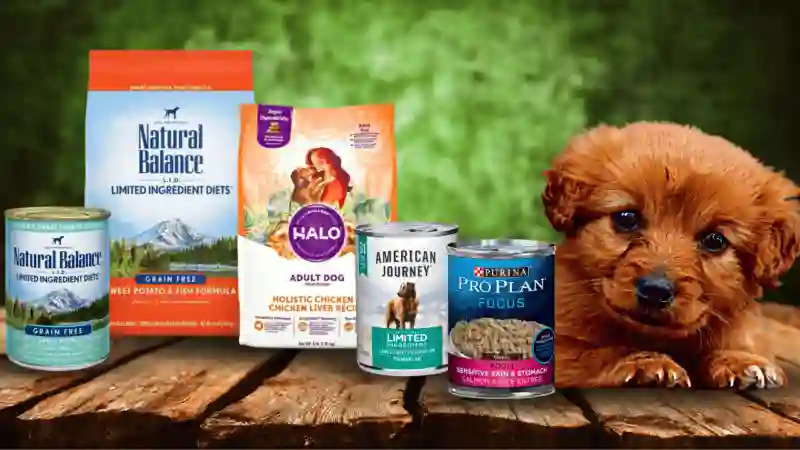Grain-Free vs. Grain-Inclusive Dog Food: Pros and Cons
- 1900 Views
- Nicholas Éric
- January 20, 2024
- Food
Choosing the right dog food for your furry companion is a decision that involves considering various factors, and one of the ongoing debates in the pet nutrition world revolves around grain-free and grain-inclusive options. Both have their advocates, and understanding the pros and cons of each can help pet owners make informed decisions based on their dog’s unique needs. In this article, we will explore the advantages and disadvantages of grain-free and grain-inclusive dog food to guide you in selecting the most suitable diet for your beloved canine.
Grain-Free Dog Food:
Pros:
- Potential Allergen Reduction: Grain-free dog food eliminates common grains such as wheat, corn, and soy. For dogs with grain allergies or sensitivities, this can be beneficial. Some dogs may experience gastrointestinal issues, skin problems, or other allergic reactions to grains, and a grain-free diet may help alleviate these symptoms.
- High-Quality Protein Sources: Grain-free dog foods often prioritize high-quality protein sources, such as real meat, as the main ingredient. This can contribute to better muscle development, increased energy levels, and overall improved health for your dog.
- Weight Management: Grain-free diets may be suitable for dogs with weight management issues. These diets often contain higher protein levels and lower carbohydrate content, promoting a sense of fullness and potentially aiding in weight control.
- Potential for Reduced Flatulence: Some dogs on grain-free diets experience reduced flatulence. While this can vary between individual dogs, the absence of certain grains may contribute to less gas production, leading to a more comfortable living environment for both dogs and their owners.
Cons:
- Risk of Nutritional Imbalance: Without grains, some grain-free dog foods may lack certain nutrients that are naturally found in grains. It’s crucial to choose a well-balanced grain-free formula or supplement the diet appropriately to prevent nutritional imbalances, especially concerning fiber and essential vitamins.
- Cost Considerations: Grain-free dog foods are often pricier than their grain-inclusive counterparts. The cost can be a significant factor for pet owners on a budget, and it’s essential to weigh the benefits against the additional expense.
- Limited Fiber Content: Grains are a natural source of dietary fiber, and a grain-free diet may lack the necessary fiber for healthy digestion. This could potentially lead to constipation or other gastrointestinal issues, especially in dogs with sensitive stomachs.
- Not Universally Beneficial: While some dogs may benefit from a grain-free diet, it’s not universally applicable. Many dogs tolerate grains well, and for them, eliminating grains may not offer any significant health advantages. A one-size-fits-all approach may not be suitable when it comes to grain-free dog food.
Grain-Inclusive Dog Food:
Pros:
- Source of Essential Nutrients: Grains, such as brown rice, oats, and quinoa, are excellent sources of essential nutrients, including carbohydrates, fiber, and certain vitamins and minerals. These nutrients contribute to overall health, energy levels, and digestion in dogs.
- Cost-Effective: Grain-inclusive dog food tends to be more affordable than grain-free alternatives. This makes it a practical choice for pet owners on a budget who still want to provide their dogs with a nutritionally balanced diet.
- Digestive Health: The fiber content in grains promotes healthy digestion and regular bowel movements. For dogs with sensitive stomachs or prone to gastrointestinal issues, a grain-inclusive diet can contribute to a well-functioning digestive system.
- Variety of Options: There is a wide variety of grain-inclusive dog food options available, catering to different dietary needs, life stages, and preferences. This diversity allows pet owners to choose a formula that aligns with their dog’s specific requirements.
Cons:
- Potential Allergies or Sensitivities: Some dogs may have allergies or sensitivities to certain grains, such as wheat or corn. In such cases, it becomes crucial to identify the specific grain causing the issue and choose a dog food that excludes that particular grain while still incorporating others.
- Lower Protein Density: Grain-inclusive dog foods may have a lower protein density compared to grain-free options. While the protein content is still significant, pet owners with highly active dogs or those looking to support muscle development may prefer a higher protein diet.
- Weight Management Challenges: The higher carbohydrate content in grain-inclusive dog food may present challenges for dogs requiring strict weight management. Pet owners must monitor their dog’s weight and adjust portion sizes accordingly to prevent excess calorie intake.
- Potential for Food Sensitivities: While many dogs tolerate grains well, some may develop sensitivities over time. It’s essential to monitor your dog’s response to their diet and consult with a veterinarian if you notice any signs of allergies or sensitivities.
Conclusion:
The choice between grain-free and grain-inclusive dog food ultimately depends on your dog’s individual needs, preferences, and health considerations. Both options have their advantages and disadvantages, and what works for one dog may not be suitable for another. It’s essential to carefully evaluate your dog’s health, consult with your veterinarian, and experiment with different diets if necessary to find the best fit. Whether you opt for grain-free or grain-inclusive dog food, prioritize high-quality ingredients, nutritional balance, and your dog’s overall well-being.





